#richard brompton
Explore tagged Tumblr posts
Text

Edward, Duke of York (1739-67) with his Friends in Venice
Artist: Richard Brompton (English, 1734-88)
Date: 1764-1765
Medium: Oil on canvas
Collection: Royal Collection Trust, United Kingdom
Description
Edward, Duke of York (1739-1767), set off on a Grand Tour of Italy in the summer of 1763, at the age of 24. After first visiting Genoa, Florence and Rome, he travelled to Venice in May 1764. He spent three weeks there, hosted in lavish style by several Venetian noblemen, in the company of members of his Household and other English gentlemen.
It is surrounded by these men that the Duke of York is depicted by Richard Brompton: the Duke sits in the centre, wearing the ribbon and star of the Order of the Garter; on the left stands the Duke’s Master of the Horse, Sir William Boothby (1721-87) with his arm around the shoulders of the Duke’s Groom of the Bedchamber, Colonel Henry St. John (c. 1738-1818); on the right, Whig politician and Dilettanti Society member Henry Temple, 2nd Viscount Palmerston (1739-1802) leans his arm on the Duke’s seat, with Resident at Venice John Murray (d. 1775), the Earl of Upper Ossory, John Fitzpatrick (1745-1818) and the grandson of the 1st Duke of St Albans, Topham Beauclerk (1739-80) also standing beside him. Brompton may have been commissioned to produce the work by Murray, and though the group portrait is set in Venice it is likely that Brompton did not start painting it until the party travelled on to Padua.
In this painting, Brompton followed a growing tradition of Grand Tour group portraiture. An Antique vase, upon which a relief of Leda and the Swan can be discerned, sits on a high plinth in the centre of the painting, above the Duke of York. Thus, both the Duke and the cultural education he was experiencing are prominent. Not only is his status made clear by his attire, his positioning and the gestures of his companions, but the Duke’s name is actually inscribed on one of the greyhounds’ collars, on the left-hand side.
#group portrait#painting#european art#british royals#oil on canvas#landscape#full length#costume#Richard brompton#english painter#European#18th century art
11 notes
·
View notes
Photo
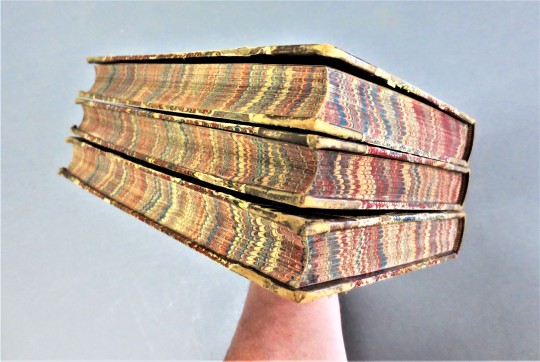

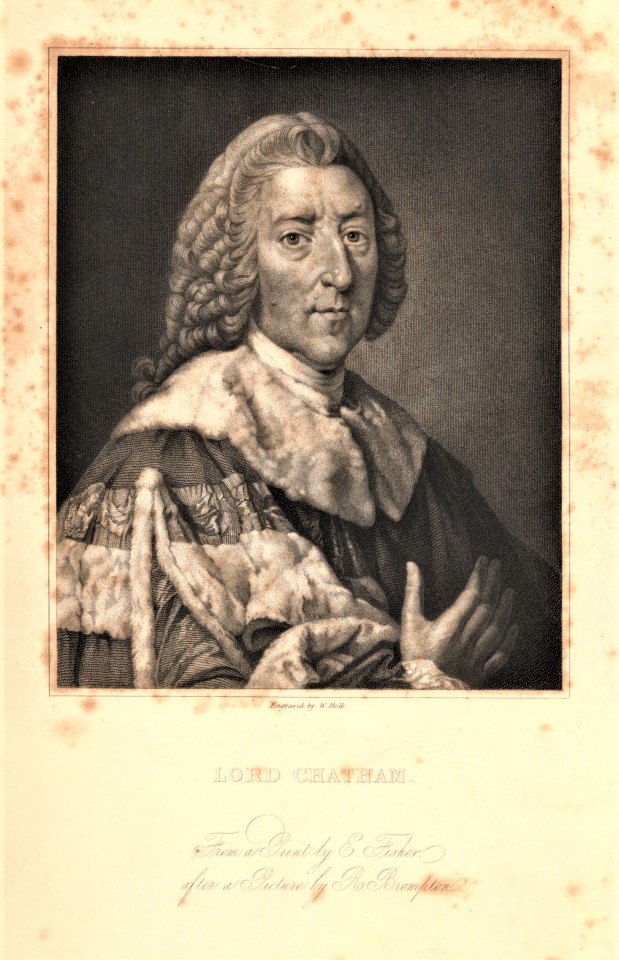
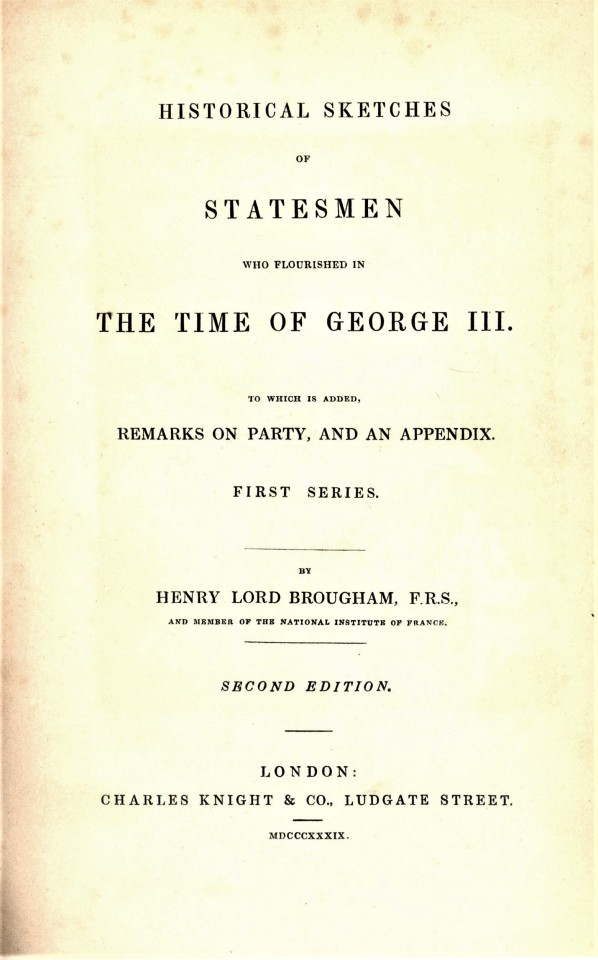






Fore Edge Friday
Here are some nonpareil bindings, edges, and endpapers for some nonpareil (e.g., unparalleled) Historical Sketches of Statesmen Who Flourished in the Time of George III by Henry, Lord Brougham, the second edition printed in three volumes in London by William Clowes and Sons for Charles Knight & Co., 1839-43. The volumes are half-bound in gold-stamped and blind-tooled calf skin with cover papers, edges, and endpapers marbled in what the University of Washington’s site on Patterned Papers identifies as a Nonpareil pattern. We have described the process for making this pattern in a previous post.
The author, Henry Peter Brougham, 1st Baron Brougham and Vaux (1777-1868), was a prolific writer on science, philosophy, and history, and published this set after his stint as Lord High Chancellor of Great Britain (1830-34). The volumes are dedicated to his wife Mary Anne Eden, 1st Baroness Brougham and Vaux (1785–1865).
The set is replete with with engravings of its subjects and each volume bears a frontispiece of a statesman. Shown here are the frontispiece portraits of William Pitt, 1st Earl of Chatham (volume 1) engraved by William Holl the Younger after an engraving by Edward Fisher from a painting by Richard Brompton, and George Washington (volume 2) engraved by William Humphrys after a painting by Gilbert Stuart. Despite the prominence of Washington’s portrait as the frontispiece to volume 2, Brougham only spends five pages on him. Nevertheless, he calls Washington “the greatest man of our own or of any age. . . . It will be the duty of the Historian and the Sage in all ages to let no occasion pass of commemorating this illustrious man; and until time shall be no more will a test of the progress which our race has made in wisdom and in virtue be derived from the veneration paid to the immortal name of Washington!”
View our other Fore Edge Friday posts.
#Fore Edge Friday#marbled papers#marbled edges#marbled book edges#Nonpareil marbling#Nonpareil pattern#marbling#paper marbling#Henry Peter Brougham#William Clowes and Sons#Charles Knight & Co.#Historical Sketches of Statesmen Who Flourished in the Time of George III#Mary Anne Eden#William Pitt#George Washington#William Holl#Edward Fisher#richard brompton#william humphrys#Gilbert Stuart#engravings#portraits#frontispiece portraits#engraved frontispiece
27 notes
·
View notes
Photo

Portrait of Catherine II (1782). Richard Brompton (English, 1734-1783). Oil on canvas. The Hermitage, St. Petersburg.
In this painting Brompton depicted Catherine II at the age of 53 with a whole set of attributes that emphasized her status and grandeur: the small imperial crown, an ermine mantle, the great chain of the Order of St Andrew the First-Called and the sash of the Order of St George 1st class. The Empress’s face deserves particular attention. The fine multi-layered painting is smooth, with hardly any texture. The image skilfully captured by the artist reveals to us for an instant Catherine the woman, calmly viewing her affairs with an inner dignity. Catherine mentioned the painting in her correspondence and described it as successful.
111 notes
·
View notes
Photo

1781 Richard Brompton - Grand Dukes Alexander Pavlovich (future Emperor Alexander I of Russia) and Constantin Pavlovich
(State Hermitage Museum)
63 notes
·
View notes
Photo

Richard BROMPTON, Portrait of Catherine II c. 1782 Oil on canvas, 83 x 69 cm The Hermitage, St. Petersburg
26 notes
·
View notes
Photo

George, Prince of Wales (1762-1830)
By Richard Brompton, 1771
25 notes
·
View notes
Photo

Tomb of Frederick Richards Leyland, Brompton Cemetery, West Brompton, London, England
#tomb#Frederick Richards Leyland#art nouveau#Pre-Raphaelite#Art patron#Edward Burne-Jones#brompton cemetery#west brompton#london
5 notes
·
View notes
Photo

Richard Brompton, ca.1734-1783
Miss Sophia Finch as a Vestal Virgin, 1779, oil on canvas, 128x98 cm
Mount Edgcumbe House (Torpoint), Inv. Plymm.049
5 notes
·
View notes
Photo

John Jackson - William Seguier (1772-1843), British art dealer, painter and first Keeper of the National Gallery - 1830
William Seguier (9 November 1772 – 5 November 1843) was a British art dealer, painter, and official functionary in the art world. He was the first Keeper of the National Gallery, London.
Seguier was born in the parish of St Martin-in-the-Fields in London, the descendant of French Huguenot refugees.
Many of his relatives were involved in the arts on a professional level, from his father David, a picture dealer, to his uncle on the paternal side, the sculptor Peter Seguier.
Initially Seguier worked as an artist; he may have been taught by George Morland and perhaps even William Blake. However, his marriage to Anne Magdalene Clowden (a fellow Huguenot), gave him the independent means to establish a dealership, and he largely gave up painting thereafter. The business, in which his brother also worked, also offered picture-cleaning and restoring services, a useful way of getting to know collectors.
From 1806, when Lord Grosvenor consulted him on the purchase of the Agar collection, Seguier's clientele became ever more aristocratic and well-connected, including such names as Sir George Beaumont, Sir Abraham Hume, Sir Robert Peel and the Duke of Wellington.
Beaumont and Grosvenor were also members of a group of connoisseurs and artists (including David Wilkie and Benjamin Haydon) that called itself "the clique", to which Seguier was admitted. Through such connections as these, the opportunistic Seguier secured a number of high-ranking official positions, beginning in 1805 with his appointment as Superintendent of the newly formed British Institution. This was followed in 1820 with the post of Surveyor of the King's Pictures, and upon the foundation of the National Gallery in 1824 he was appointed its Keeper.
The Superintendent was responsible for organizing and hanging the shows at the British Institution, a role that inevitably gave rise to grumbling and worse from artists - at the Royal Academy a committee was responsible for the hang, which allowed someone else to be blamed, but Seguier had no such opportunity to share the blame. In 1833 John Constable wrote with heavy irony of having received a visit in his studio from "a much greater man than the King—the Duke of Bedford—Lord Westminster—Lord Egremont, or the President of the Royal Academy — "MR SEGUIER"." When in 1832 two pictures by Richard Parkes Bonington, who had been dead only four years, were included in an "Old Masters" exhibition, Constable (who was twenty-six years older than Bonington) wrote that Seguier was "carrying on a Humbugg". The William Blake scholar Ruthven Todd tells us that at the National Gallery Seguier "established a reputation both for incompetence and for a passion for brown varnish, apparently agreeing with Sir George Beaumont, connoisseur and amateur artist, that a really good picture should have the color of a Cremona violin".
Seguier held these three positions until his death in 1843; his brother succeeded him at the British Institution. He is buried in Brompton Cemetery, London.
John Jackson RA (31 May 1778 – 1 June 1831) was a British portraitist.
10 notes
·
View notes
Photo

𝙂𝙞𝙛𝙩𝙚𝙙 🍔 This is The Richard & Mortimer from @lospollosbravos. Fried chicken thigh, peanut satay slaw, mayo, ginger & spring onion oil, and miso & Szechuan sauce. What a tasty burger! That miso and Szechuan sauce is so nice, and if you’re gonna get their wings then you need to get them coated in this too. Los Pollos Bravos are delivering from South Kensington and are definitely worth checking out if you’re in range. They’ve got banging sauces and flavours going on with their burgers, plus their sides are great too! . . . . . #friedchicken #chickenburger #chickensandwich #burger #burgers #baconcheeseburger #london #londonfood #londoneats #londonist #londonlife #southkensington #kensington #burgerlove #burgerlover #burgerlovers #burgerlife #burgerporn #londonburger #burgertime #burgersofinstagram #foodphotos #foodpicoftheday #burgerday #burgersofinstagram #burgerholic #burgerheaven #sataychicken #satay #miso #szechuan (at Old Brompton Road, South Kensington) https://www.instagram.com/p/CM9O4EjhvTJ/?igshid=8jbecl5fl486
#friedchicken#chickenburger#chickensandwich#burger#burgers#baconcheeseburger#london#londonfood#londoneats#londonist#londonlife#southkensington#kensington#burgerlove#burgerlover#burgerlovers#burgerlife#burgerporn#londonburger#burgertime#burgersofinstagram#foodphotos#foodpicoftheday#burgerday#burgerholic#burgerheaven#sataychicken#satay#miso#szechuan
8 notes
·
View notes
Photo

John Horne Tooke (1736–1812)
Richard Brompton (c.1734–1783)
Manchester Art Gallery
1 note
·
View note
Photo

Saint Æthelberht of East Anglia, King and Martyr
Commemorated on 20 May/2 June
Æthelberht II, also called Saint Ethelbert the King (died 20 May 794 at Sutton Walls, Herefordshire), was an eighth-century saint and a king of East Anglia, the Anglo-Saxon kingdom which today includes the English counties of Norfolk and Suffolk. Little is known of his reign, which may have begun in 779, according to later sources, and very few of the coins issued during his reign have been discovered. It is known from the Anglo-Saxon Chronicle that he was killed on the orders of Offa of Mercia in 794.

Kingdom of East Anglia
Little is known of Æthelberht’s life or reign, as very few East Anglian records have survived from this period. According to Richard of Cirencester, writing in the fifteenth century, Æthelberht’s parents were Æthelred I of East Anglia and Leofrana of Mercia. Richard narrates in detail a story of Æthelberht’s piety, election as king and wise rule. Urged to marry against his will, he apparently agreed to wed Eadburh, the daughter of Offa of Mercia, and set out to visit her, despite his mother’s forebodings and his experiences of terrifying events (an earthquake, a solar eclipse and a vision).
The site of Æthelberht’s murder was apparently the royal villa at Sutton Walls, four miles north of modern Hereford. Mediaeval sources tell how he was taken captive while visiting his future Mercian bride Ælfthyth and was then murdered and buried. In Richard of Cirencester’s account of the murder, which cannot be substantiated, Offa’s evil queen Cynethryth poisoned her husband’s mind until he agreed to have his guest killed.

Sutton Walls Hill Fort in Herefordshire, Mercia
Æthelberht was then bound and beheaded by a certain Grimbert and his body was unceremoniously disposed of. The mediaeval historian John Brompton’s Chronicon describes how the king’s detached head fell off a cart into a ditch where it was found, before it restored a blind man’s sight. According to the Chronicon, Ælfthyth subsequently became a recluse at Crowland and her remorseful father founded monasteries, gave land to the Church and went on a pilgrimage to Rome.
After his death, Æthelberht was locally canonised by the Church (local canonisation took place before official papal canonisation was established in 1634). He became the subject of a series of vitae that date from the eleventh century and he was venerated in religious cults in both East Anglia and at Hereford, Mercia.

The Mother of God with St. John the Baptist and St. Æthelberht - by Peter Murphy
4 notes
·
View notes
Text
A Surprise Victory for Robert Mylne
On September 23rd, 1758, an aspiring architect named Robert Mylne (1733 – 1811) wrote to his younger brother William (1734 – 1790) with astonishing news. At twenty-four years old, Robert had just become the first Briton awarded top prize in the Concorso Clementino, a famous architecture competition held every three years in Rome.[1] This drawing of an altar—completed during a timed exam—was submitted as part of his winning entry.
Portrait of Robert Mylne, 1783; engraved by Vincenzo Vangelisti after a drawing by Richard Brompton (1757); National Portrait Gallery, London, NPG D5326
Robert and William Mylne were Scottish, born in Edinburgh to a family of builders: their ancestors were stonemasons.[2] After preliminary training in their native city, the brothers continued their architectural education in Europe. They traveled first to France, then made their way (mostly by foot, on account of the cost) to Rome, where they arrived in 1755.[3] In the Eternal City, Robert and William studied antiquities, attended lectures at the Accademia di San Luca (Academy of St. Luke), and built relationships with prominent architects such as Giovanni Battista Piranesi (1720 – 1778).[4] Unable to disguise their modest origins, in Rome the Mylne brothers earned the scorn of Robert Adam (1728 – 1792), a Scottish architect of much greater means. Adam described them as having “neither education nor money,” though he noted begrudgingly that Robert “begins to draw extremely well.” [5] In 1757, William returned to Edinburgh. Robert however remained in Rome, determined to try his hand at the Concorso Clementino.
The contest, named in honor of Pope Clement XI, had been established by the Academy in 1702.[6] It carried enormous prestige, and was specifically intended for architects early in their careers. The competition consisted of two separate trials. First, several months before each Concorso, the Academy would announce the subject for the upcoming contest. In Robert Mylne’s year, the contestants were tasked with producing a series of drawings for “A Public Building with a Memorial Gallery to exhibit Busts of Eminent Men.”[7] When the deadline arrived, competitors submitted plans, sections, elevations, and whatever other drawings they felt would convince the judges of the superiority of their projects.
Robert Mylne, Interior and Exterior Longitudinal Sections, Concorso Clementino, 1758; Rome, Accademia Nazionale di San Luca. (The yellow color of this drawing is the result of extended exposure to light during display.)
In the second phase of the contest, the architects gathered for an extemporaneous feat of drawing, the subject kept secret until the event. Mylne sat for this test, called a prova, on the 7th of September, 1758.[8] Afterwards, he recalled the experience in the letter to his brother: sitting before a panel of judges, the competitors were given two hours to design a “magnificent” altar adorned with composite columns.[9] “I am sure you are quaking for me now,” Mylne wrote, “however I made it out and a fine one—in comparison with the rest.”[10] What he produced was this relatively simple sheet in the Cooper Hewitt collection, bearing the elevation and plan of an altar in a modern, French-inflected Neoclassical style. At the top, the architect has added and identified allegorical figures of Hope, Humility, and Faith. A few days after the prova, Mylne learned he had been unanimously selected for the first prize. The announcement shocked him. “I think on my heart when I received the news—thump, thump, thump, I feel it yet…”[11]
His triumph in the Concorso Clementino launched Mylne’s career. In Rome he was honored with a fabulous ceremony attended by Cardinals, and presented with a silver medal. His winning drawings were displayed in the Academy building and earned much praise (although not from Robert Adam and his supporters, who—full of sour grapes—continued to sneer). [12] Mylne returned to Britain the following year, where his Italian victory was soon overshadowed by another major success. In 1760 he submitted drawings for a competition to design the new bridge over the Thames at Blackfriars. And won. [13]
A View of Part of the Intended Bridge at Blackfriars, London, ca. 1764; etched by Giovanni Battista Piranesi; Metropolitan Museum of Art, 62.600.683
Dr. Julia Siemon is Assistant Curator of Drawings, Prints & Graphic Design at Cooper Hewitt, Smithsonian Design Museum
[1] Damie Stillman, “British Architects and Italian Architectural Competitions, 1758 – 1780,” Journal of the Society of Architectural Historians, Vol.32, No. 1 (Mar., 1973): 44 – 66, 44 – 45
[2] A. E. Richardson, Robert Mylne: Architect and Engineer, 1733 to 1811 (London: B.T. Batsford, 1955), 15
[3] William first went to France on his own, where he studied for a period before being joined by Robert so that the brothers could travel together to Italy. Stana Nendacic, “Architect-Builders in London and Edinburgh, c. 1750 – 1800, and the Market for Expertise,” The Historical Journal, Vol. 55, No. 3 (September 2012): 596 – 617, 599
[4] Richardson, 14
[5] Lindsay Stainton, “Hayward’s List: British Visitors to Rome, 1753 – 1775,” The Volume of the Walpole Society, Vol. 49 (1983): 3 – 36, 28; Nenacic, 611
[6] Stillman, 44
[7] Stainton, 28. The rules of the competition listed several specific requirements, including architectural elements such as an atrium, a theater, etc., as well as clarifications regarding the submission of a “plan, prospect, and section, and anything else that might be required to give a good demonstration of the idea.” These were printed in a celebratory publication for the awards ceremony, Delle lodi delle bele arti… del concorso celebrate dall’insigne Accademia del Disigno di S. Luca… l’anno MDCCLVII (Rome, 1758).
[8] Stillman, ibid. The Cooper Hewitt collection also includes a prova carried out by another British architect, Joseph Gandy, who won the Concorso Clementino in 1795.
[9] “Magnifico Altare con colonne d’Ordine composito per farsi in una della principali Capelle con suoi ornati.” See Stillman, 45
[10] Robert Mylne to William Mylne, 23 September, 1758, in Stillman, 44.
[11] Mylne in Stillman, ibid.
[12] Stillman, 41 n. 21.; 44
[13] For the bridge, see Roger Woodley, “‘A Very Mortifying Situation’: Robert Mylne’s Struggled to Get Paid for Blackfriars Bridge,” Architectural History, Vol. 43 (2000): 172 – 186
from Cooper Hewitt, Smithsonian Design Museum https://ift.tt/3gIycw3 via IFTTT
1 note
·
View note
Note
hey hello im writing a piece for laptop ensemble that involves sampling and i need the most repressed/tender/yearning quotes you got. just as gay and heart wrenching as you can. but also no pressure I know youre a stranger on the web I just feel like you post that kind of stuff a lot thank you bye
hope this isnt like too late school keeps me busy :( (also can you put a read more on asks? guess i’ll find out). i ended up choosing many quotes from the same texts cause im indecisive as shit but i’ll bold my favorites from those in case that makes it easier for you!
anyways first of all you can never go wrong w richard siken as obvious as that is. these are both from you are jeff
You’re in a car with a beautiful boy, and he won’t tell you that he loves you, but he loves you. And you feel like you’ve done something terrible, like robbed a liquor store, or swallowed pills, or shoveled yourself a grave in the dirt, and you’re tired. You’re in a car with a beautiful boy, and you’re trying not to tell him that you love him, and you’re trying to choke down the feeling, and you’re trembling, but he reaches over and he touches you, like a prayer for which no words exist, and you feel your heart taking root in your body, like you’ve discovered something you don’t even have a name for.
Let’s say you’ve swallowed a bad thing and now it’s got its hands inside you. This is the essence of love and failure. You see what I mean but you’re happy anyway, and that’s okay, it’s a love story
this one’s from planet of love (the format got fucked bc tumblr is not actually a finctional website but :/ )
I have a megaphone and you play along, because you want to die for love, you always have. Imagine this:You’re pulling the car over. Somebody’s waiting. You’re going to die in your best friend’s arms. And you play along because it’s funny, because it’s written down,you’ve memorized it,
from litany in which certain things are crossed out
I make you pancakes, I take you hunting, I talk to you as if you’re really there.Are you there, sweetheart? Do you know me? Is this microphone live? Let me do it right for once,
sorry about the scene at the bottom of the stairwell and how I ruined everything by saying it out loud. Especially that, but I should have known.You see, I take the parts that I remember and stitch them back together to make a creature that will do what I sayor love me back.
We were inside the train car when I started to cry. You were crying too, smiling and crying in a way that made meeven more hysterical. You said I could have anything I wanted, but I just couldn’t say it out loud.Actually, you said Love, for you, is larger than the usual romantic love. It’s like a religion. It’s terrifying. No one will ever want to sleep with you.
from snow and dirty rain
I had a dream about you. We were in the gold roomwhere everyone finally gets what they want.
that scene from when harry met sally where sally says:
One day I was taking Alice’s little girl fro the afternoon. I’d promised to take her to the circus, and we were in a cab playing “I spy” - you know, “I spy a lamppost”, “I spy a mailbox” - and she looked out the window and there was this man and this woman with two little kids, and the man had one of the kids on his shoulders, and Alice’s little girl said “I spy a family”, and I satrted crying, you know? I just started crying, and I went home
(like anyone else sometimes cries when u see a family doing something nice? is it because i want to participate in a sense of family of my own but have been excluded as a gay person from it’s portrayals and it makes me go :^( cause i dont feel there’s room for me there but i want there to be and i just have to long for this nuclear family heteronormative way of life that i’ve been made to believe is idylic? is it because my parents got divorced and my dad’s an ass and my mom is just a very angry lady and i want to re-do my own childhood? who knows. should we ban movies? yes we should!)
from maurice (ultimate source of tender)

“There was something better in life than this rubbish, if only he could get to it, love, nobility, big spaces where passion clasped peace, spaces no science could reach, but they existed for ever, full of woods some of them, and arched with majestic sky and a friend”
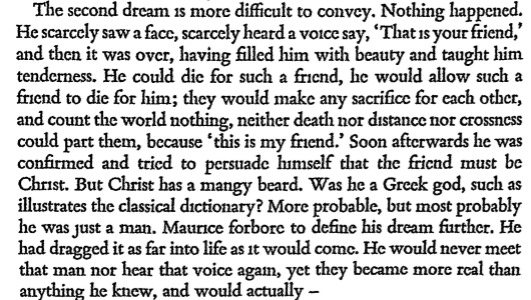
‘Did you ever dream you had a friend, Alec? Nothing else but just “my friend”, he trying to help you and you him. A friend’ he repeated, sentimental suddenly. ‘Someone to last your whole life and you his. I suppose such a thing can’t really happen outside sleep’
we are all so lucky i don’t actually own maurice in english this would just turn into me quoting the whole book
ee cummings voices to voices, lip to lip
the thing perhaps isto eat flowers and not to be afraid.
from virgina woolf’s letters to vita
7 september 1925
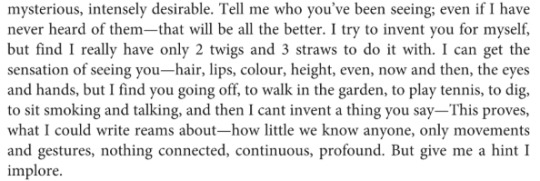
january 21 1926 vita writes
I am reduced to a thing that wants Virginia. I composed a beautiful letter to you in the sleepless nightmare hours of the night, and it has all gone: I just miss you, in a quite simple desperate human way. You, with all your un-dumb letters, would never write so elementary phrase as that; perhaps you wouldn’t even feel it. And yet I believe you’ll be sensible of a little gap. But you’d clothe it in so exquisite a phrase that it would lose a little of its reality. Whereas with me it is quite stark: I miss you even more than I could have believed; and I was prepared to miss you a good deal. So this letter is just really a squeal of pain. It is incredible how essential to me you have become. I suppose you are accustomed to people saying these things. Damn you, spoilt creature; I shan’t make you love me any the more by giving myself away like this—But oh my dear, I can’t be clever and stand-offish with you: I love you too much for that. Too truly. You have no idea how stand-offish I can be with people I don’t love. I have brought it to a fine art. But you have broken down my defences. And I don’t really resent it …
and on january 26 virginia writes back
Your letter from Trieste came this morning—But why do you think I don’t feel, or that I make phrases? ‘Lovely phrases’ you say which rob things of reality. Just the opposite. Always, always, always I try to say what I feel. Will you then believe that after you went last Tuesday—exactly a week ago—out I went into the slums of Bloomsbury, to find a barrel organ. But it did not make me cheerful … And ever since, nothing important has happened—Somehow its dull and damp. I have been dull; I have missed you. I do miss you. I shall miss you. And if you don’t believe it, you’re a longeared owl and ass. Lovely phrases? …
from virginia’s diary, about vita on december 21 1925
I like her and being with her and the splendour–she shines in the grocer’s shop in Sevenoaks with a candle lit radiance, stalking on legs like beech trees, pink glowing, grape clustered, pearl hung.
from virginia woolf’s to the light house
What device for becoming, like waters poured into one jar, inextricably the same, one with the object one adored? Could the body achieve, or the mind, subtly mingling in the intricate passages of the brain? or the heart? Could loving, as people called it, make her and Mrs Ramsay one? for it was not knowledge but unity that she desired, not inscriptions on tablets, nothing that could be written in any language known to men, but intimacy itself, which is knowledge, she had thought, leaning her head on Mrs Ramsay’s knee. Nothing happened. Nothing! Nothing! as she leant her head against Mrs Ramsay’s knee. And yet, she knew knowledge and wisdom were stored up in Mrs Ramsay’s heart.
Love had a thousand shapes. There might be lovers whose gift it was to choose out the elements of things and place them together and so, giving them a wholeness not theirs in life, make of some scene, or meeting of people (all now gone and separate), one of those globed compacted things over which thought lingers, and love plays.
there forced themselves upon her other things, her own inadequacy, her insignificance, keeping house for her father off the Brompton Road, and had much ado to control her impulse to fling herself (thank Heaven she had always resisted so far) at Mrs Ramsay’s knee and say to her—but what could one say to her? “I’m in love with you?” No, that was not true. “I’m in love with this all,” waving her hand at the hedge, at the house, at the children. It was absurd, it was impossible
(fun fact: the spanish translation adds something that i’d translate as “one could not say what one meant / what one wanted to say”, which i really like and i was disapointed to find out isnt on the english edition)
It was love, she thought, pretending to move her canvas, distilled and filtered; love that never attempted to clutch its object; but, like the love which mathematicians bear their symbols, or poets their phrases, was meant to be spread over the world and become part of the human gain. So it was indeed. The world by all means should have shared it
from the great gatsby
I didn’t want to go to the city. I wasn’t worth a decent stroke of work but it was more than that—I didn’t want to leave Gatsby. I missed that train, and then another, before I could get myself away (…) Just before I reached the hedge I remembered something and turned around. ‘They’re a rotten crowd,’ I shouted across the lawn. ‘You’re worth the whole damn bunch put together.’ I’ve always been glad I said that. It was the only compliment I ever gave him
from kafka’s diaries
may 27 1911: Today is your birthday, but I am not even sending you the usual book, for it would be only pretence; at bottom I am after all not in position to give you a book. I am writing only because it is so necessary for me today to be near you for a moment
parts from a from a letter he wrote to oskar pollak on february 4 1902
When we talk together the words are hard; we tread over them as if they were rough pavement. The most delicate things acquire awkward feet and we can’t help it. We’re almost in each other’s way; I bump into you and you - I don’t dare and you. When we come to things that are not exactly cobblestones or the Kunstwart, we suddenly see that we are in masquerade, acting with angular faces (especially me, I admit), and then we become sad and bored. Does anyone make you as bored as I do?
then I fall silent and you fall silent and you become bored, and I become bored and it’s all like a stupid hangover and there’s no use lifting a hand. But neither wants to say this to the other, out of shame or fear or - You see, we are afraid of each other, or I am.
Of course I understand it. It’s boring to stand for years in front of an ugly wall and it just won’t crumble away. Of course, but the wall is afraid for itself, fro the garden (if there is one), and you get out of sorts, yawn, have headaches, don’t know where to turn
You often talk with her, not only for the sake of talking. You walk around with her somewhere here or there, or in Roztok, and i sit at my desk at home. You talk with her, and in the middle of a sentence somebody jumps up and makes a bow. That is me with my untrimmed words and angular faces. That lasts only a moment, and then you go on talking. I sit at my desk at home and yawn. I’ve been trhough it already. Wouldn’t that separate us? Is that so strange? Are we enemies? I am very fond of you
from his leters to milena
Last night I dreamed about you. What happened in detail I can hardly remember, all I know is that we kept merging into one another. I was you, you were me. Finally you somehow caught fire.
jane wong. from clearing
We want to believe everything has meaning.Plums blossom over a power grid
and I am in love again. The shame of it.
from leslie harrison’s [sirens]
I’m not Penelope married to faith married to waitingbound in fine soft strands of silk dyed and stretchedin my world longing has teeth and fins has a tastefor blood longing is a room built entirely of knives
Lorde’s melodrama tour interlude
Don’t you wish you could go inside a heart, see the strings and atrium’s, everything beating and bleeding. It’s kind of funny, I spend almost every minute thinking about love. Being guided, and divided by love. But I’ve never seen it. It’s just a rumour, a comedown, an afterglow. I wanna see it, in colour. In the summer, I can almost picture it
from Andrea Long Chu’s on liking women
One day, you tell yourself, it will give you what you want. Then, one day, it doesn’t. Now it dawns on you that your object will probably never give you what you want. But this is not what’s disappointing, not really. What’s disappointing is what happens next: nothing. You keep your object. You continue to follow it around, stash it in a drawer, water it, tweet at it. It still doesn’t give you what you want—but you knew that. You have had another realization: not getting what you want has very little to do with wanting it. Knowing better usually doesn’t make it better. You don’t want something because wanting it will lead to getting it. You want it because you want it
ada limón, In a Mexican Restaurant I Recall How Much You Upset Me
But love is impossible and it goes ondespite the impossible. You’re the muscleI cut from the bone and still the boneremembers, still it wants (so much, it wants)the flesh back, the real thing,if only to rail against it, if onlyto argue and fight, if only to missa solve-able absence.
i dont think i need to get into mitski songs because you probably already know but basically pink in the night/come into the water/once more to see you/in happy when she says if you’re going take the train so i can hear it rumble one last rumble/in i want you from the first verse to the first time she goes “i just need a quiet place where i can scream how i love you” (YES the card thing is very important)/the first verse of i will (w emphasis on everything you feel is good i f you wold only let you)/abbey/strawberry blond
sufjan steven’s futile devices obviously predatory wasp of the palisades you know the drill
was going to find some twin fantasy lyrics but i started thinking about famous prophets (minds) and like. emotionally left my body so. i wont be thinking about it or any other songs anymore it makes me too crazy
from frances ha
It’s that thing when you’re with someone and you love them and they know it and they love you and you know it but it’s a party and you’re both talking to other people and you’re laughing and shining and you look across the room and catch each other’s eyes. But not because you’re possessive, or it’s precisely sexual, but because that is your person in this life and it’s funny and sad but only because this life will end and it’s this secret world that exists right there. In public. Unnoticed. That no one else knows about. It’s sort of like how they say that other dimensions exist all around us but we don’t have the ability to perceive them. That’s what I want out of a relationship. Or just life, I guess.
from ellen lee’s notes on twin fantasy that i revisit constantly
there’s no going back to deliver these words to the ones they were really meant for. That’s how heartbreak feels, I guess. It feels like your heart in between the teeth of someone who’s looking away. When you’ve lost your loved object, what happens to all the things you have to say to them? When they’re turned away, what happens to all the things that you couldn’t, but desperately need(ed) to, say to their face? He dissociates himself from his own romance until it becomes a fantasy. You have your bleeding heart, you have a finite set of memories — when nothing new enters and you’re unwilling to let go, then you have a fantasy. The loved object enters into you and transforms.
the journey home by dermot bolger(havent read this at all dont really plan to/dont know a thing about it either i just came across this shit like 2 years ago and i still think about it)
I wanted to hurt him; I wanted just to touch him. What I wanted I’m not really sure. If he had stopped and opened his arms I would have walked towards him; I would have sat on the kerb all night with him
adam b, sweet i have a (really gay) heart
i feel like my body is the extension of a lake. i feel really badabout not telling you the truth, sometimes. i feelreally small next to you. tall boys remind me of bean stalks.i wish i had your legs. i wish i could know your handsbefore i even touch them
aaaand i think that’s all i could think of and track down, hope this is actually helpful and not too long (i am indecisive no kidding). also ksjdfg it’s nice that you thought to ask me this and i did have fun going over all these quotes so thank you 💖💖💖
#answered#i hope this fits what you were looking for!!#and i hope read mores are working on mobile djfgk#c#thing#Anonymous
7 notes
·
View notes
Photo

1777 Richard Brompton - John Horne Tooke
(Manchester Art Gallery)
74 notes
·
View notes
Text
'What Now? I'm Going To Have My Cake And Eat It' - Tom Barnaby, Midsomer Murders
'She was very, very fat. She spread outwards and towered upwards. At least a quarter of her height seemed to be accounted for by her hair, which was a rigid pagoda-like structure: a landscape of peaks and waves, whorls and curls ending in a sharp point like an inverted ice cream cone. It was the colour of butterscotch instant whip.'

I'm shocked it's taken me such a long time to read any of the Midsomer Murders books. For a long time I didn't even realise there were books, the show being such an institution that it overshadowed all else. On the back of my copy of The Killings At Badger's Drift it says 'One of the CWA Top 100 Crime Novels of All Time'. I pondered what CWA meant. In Leicester CWA is a 'creative thinking' agency (whatever that could possibly be). College of West Anglia? Apparently it's the Crime Writers' Association. Well...great! If it was me running the show it would be at the very top. I have never been so enamoured with a book before. I had made a note on several pages before the end of the first chapter, which is a very good sign indeed. For me it was a connection. Caroline Graham writes like me. She's far superior, obviously, since she is actually a writer, but I couldn't escape the short sentences. I was always told at school not to use short sentences. Brackets and commas are the enemy and you just need to press on with the sentence, give it both barrels. But that's not who I am, that's not how I speak. I often cut myself short to go on a tangent that can only be illustrated with brackets when writing it down (god knows how people keep up with me when I am actually speaking to them. At least three sentences spring from my original sentence and end up far removed the point). She often starts writing a character's thoughts without telling you, and it's not until you're halfway through that you realise it's all in their mind and not part of their external world at all. It's brilliant! Finding someone that has written like this, who has been successful writing like this, brings me great joy. I have no ambitions to be a writer or to do anything with this newsletter other than to write it for myself (I'm so glad you all read it, I really am, but I do this for me first of all. I must do something and this is it), but finding someone else that makes me believe I am allowed to write as I want to is the best feeling in the world.
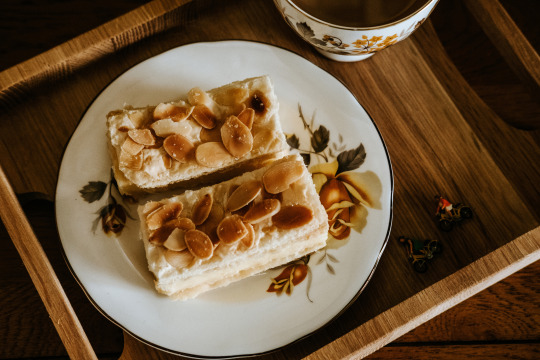
'You're a good boy,' she crooned, kissing him full on the mouth. Her breath was very sweet, a soft explosion of violet cachous and cream and rich vanilla. 'Mummysbestboy.' Her fingers slipped into his shirt, caressing the bony wings of his shoulder blades. 'Bestestonlyboy.'
I wanted to create a recipe for Barnaby first of all, since he is the main event, but when I started reading The Killings At Badger's Drift I was pacing around the room with excitement thinking about The Rainbirds. Obviously I had seen them portrayed so brilliantly by Richard Cant and Elizabeth Spriggs and loved them then, but reading Barnaby's first encounter with this repulsive duo really set me going. How ghoulishly fascinating they are. Dennis, a pale foppish undertaker, and Iris, a preened oppressive mass of a person. Barnaby thinks they would fit very well into a Joe Orton play and I can completely see that. As the quote above shows, their relationship as mother and son is not quite the usual. I'd quite like to put them behind glass at a museum and watch them, watch their eyes twinkling with conspiracy. When Barnaby and Troy meet them at their home, Dennis Rainbird wheels out a trolley 'built along the lines of the altarpiece at the Brompton Oratory', piled high with sandwiches and cakes. The sandwiches are cut into playing card shapes, which brings out their characters so well (marmite hearts, potted meat diamonds...). Poor Troy is handed a vanilla slice, which Dennis notes he isn't enjoying very much. 'Press him to a frangipane, then' is Iris Rainbird's response. I just love them hideously. They take so much care over their presentation, and they love every minute of it. I had to make the vanilla slice that Sergeant Troy has so much trouble with. It's slightly fiddly, this one, but I'm sure you'll get the hang of it. I've made it easier by using shop bought puff pastry, but I do feel The Rainbirds will be able to tell the difference! There will be a bit of wastage of the pastry here but I found myself snacking on this while the custard cooled, so I'm sure you'll be alright.
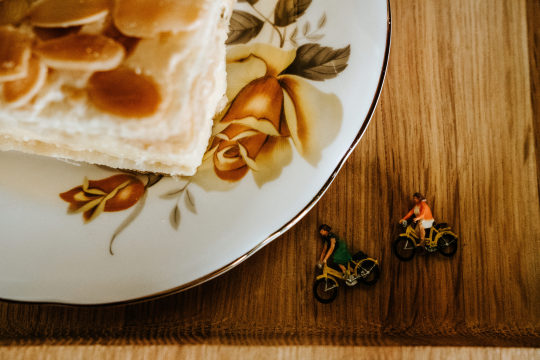
For the pastry: 2x sheets ready rolled all butter puff pastry some icing sugar, about 1-2 tbsp flaked almonds For the custard: 150ml double cream 650ml full fat milk 3 large egg yolks 100g caster sugar 1 tbsp vanilla bean paste 3 tbsp cornflour 3 tbsp custard powder Preheat the over 200C/180 fan/Gas 6. Fully line a 23cm square cake tin with baking parchment. To prepare the pastry, roll one sheet out onto a baking tray lined with parchment paper. Sprinkle the sheet with icing sugar so there's an even coating and sprinkle with flaked almonds. To prevent the pastry from rising too much, cover it with another sheet of parchment and another baking tray. If you have any baking beans or rice pour that into the tray to make sure it's well held down (puff pastry is very stubborn). Bake this in the oven for 25-30 minutes until the layer is dark in colour. Repeat this process with the second sheet of pastry to get your top layer, but leave out the ground almonds for this one. Peel the parchment off the sheets of cooked pastry. When cooled, trim each pastry slice to fit a 23cm square cake tin and place one sheet of pastry into the bottom of the tin. Set this aside while you make the custard. To make the custard, heat the vanilla, cream and milk on low until it comes to a gently boil. Remove it from the heat temporarily while you whisk together the egg yolks, cornflour, custard powder and sugar. Whisk until everything is combined but don't go over the top. We don't need to add any air to it. Pour a small amount of the hot milk onto the egg mixture and whisk continuously to bring it all together, then slowly add more of the milk until everything is mixed together. Put this back onto the heat and stir continuously until the mixture has thickened. It will naturally come to a boil but try to keep the heat fairly low so it doesn't burn the bottom of the pan. If you wish you can pass the custard through a sieve into a clean bowl to remove any lumps. Press some clingfilm onto the top of the custard to prevent a skin forming, then leave it to cool fully. Once the custard is cooled pour it over the pastry base in the tin and smooth over the top. Using a ruler, neatly cut the top layer into even slices. I cut mine to roughly 3.5cm. Unfortunately there isn't a great way of doing it evenly because of the tin sizes here. We've got 20cm, 23cm, 25cm etc so it's never quite even but do your best. Lay these slices on top of the custard and put everything into the fridge to chill for several hours. Chop the custard slices and serve, preferably on a rickety old tea trolley.
#midsomer murders#tom barnaby#joyce barnaby#john barnaby#baking#recipes#vanilla slice#cream slice#custard slice#pastry#patisserie
70 notes
·
View notes